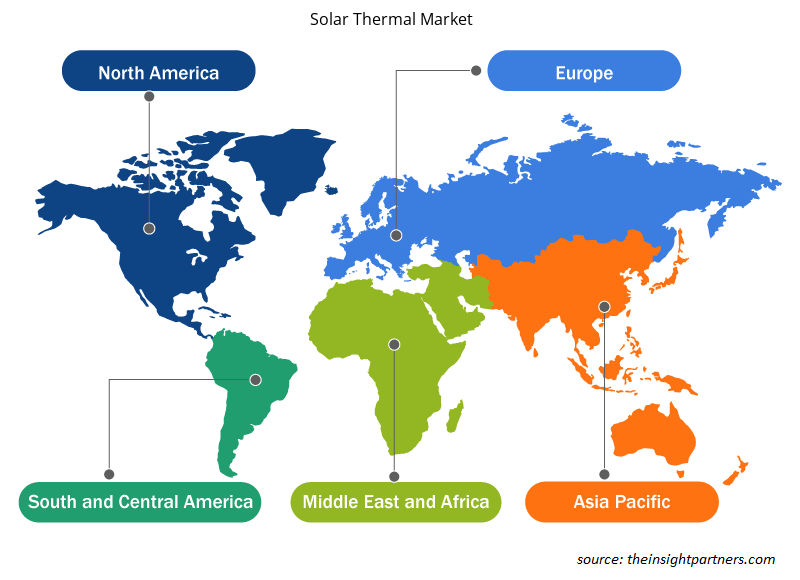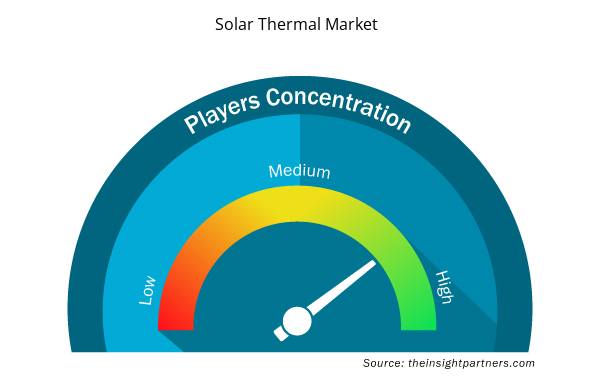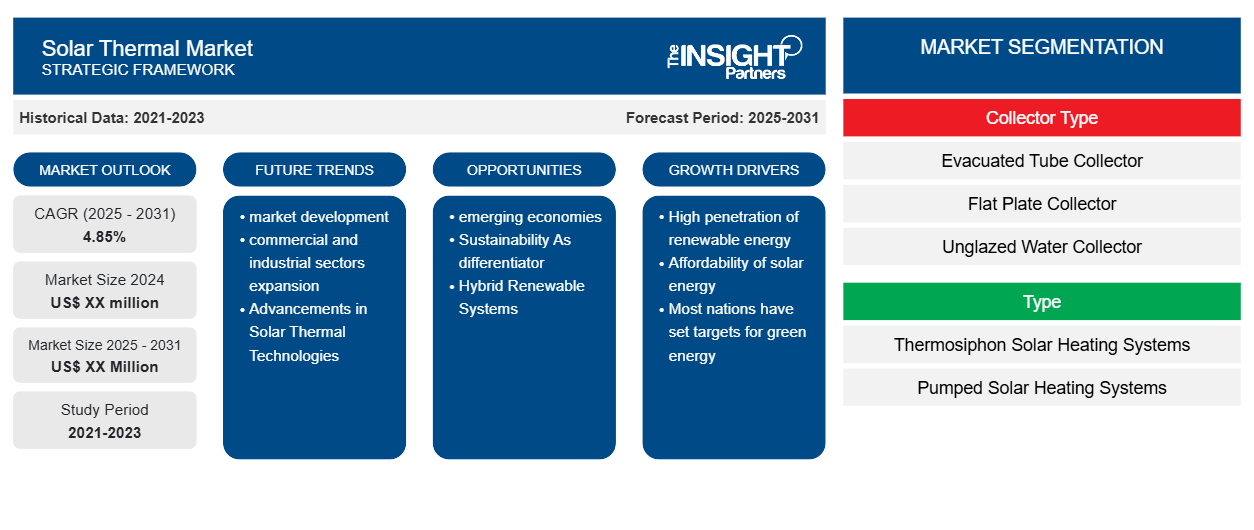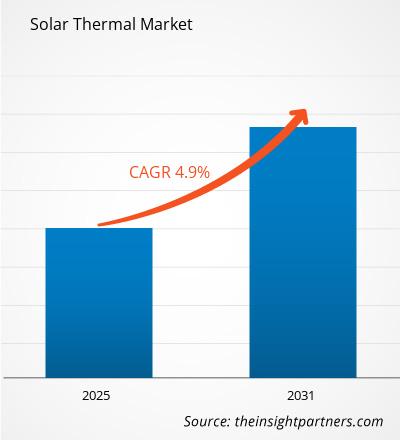Se espera que el mercado de energía solar térmica registre una CAGR del 4,85 % entre 2024 y 2031, y que el tamaño del mercado se expanda de XX millones de dólares estadounidenses en 2024 a XX millones de dólares estadounidenses en 2031.
El informe sobre el mercado de energía solar térmica ofrece un análisis profundo basado en la tecnología, las aplicaciones y las regiones geográficas. Este informe cubre una segmentación regional detallada que se centra en todos los mercados y países principales, lo que brinda una perspectiva global. Los análisis de mercado se proporcionan en dólares estadounidenses (USD). Este informe ayudará a las partes interesadas a comprender la dinámica del mercado, junto con las tendencias de crecimiento y el panorama competitivo del mercado en diferentes segmentos. Les permitirá identificar oportunidades y tomar decisiones estratégicas en el creciente mercado de energía solar térmica.
Propósito del Informe
El informe sobre el mercado de energía solar térmica elaborado por The Insight Partners tiene como objetivo describir el panorama actual y el crecimiento futuro, los principales factores impulsores, los desafíos y las oportunidades. Esto proporcionará información a diversas partes interesadas del negocio, como:
- Proveedores/fabricantes de tecnología: Para comprender la dinámica cambiante del mercado y conocer las oportunidades potenciales de crecimiento, lo que les permitirá tomar decisiones estratégicas informadas.
- Inversionistas: Realizar un análisis exhaustivo de tendencias sobre la tasa de crecimiento del mercado, las proyecciones financieras del mercado y las oportunidades que existen en toda la cadena de valor.
- Órganos reguladores: Regular las políticas y vigilar las actividades del mercado con el objetivo de minimizar los abusos, preservar la confianza de los inversores y defender la integridad y la estabilidad del mercado.
Segmentación del mercado de energía solar térmica
Tipo de coleccionista
- Colector de tubos de vacío
- Colector de placa plana
- Colector de agua sin esmaltar
- Colector de aire
Tipo
- Sistemas de calefacción solar por termosifón
- Sistemas de calefacción solar por bombeo
Solicitud
- Sistemas de agua caliente sanitaria
- Grandes sistemas de agua caliente sanitaria
- Sistema combinado solar
Geografía
- América del norte
- Europa
- Asia-Pacífico
- América del Sur y Central
- Oriente Medio y África
Personalice este informe según sus necesidades
Obtendrá personalización en cualquier informe, sin cargo, incluidas partes de este informe o análisis a nivel de país, paquete de datos de Excel, así como también grandes ofertas y descuentos para empresas emergentes y universidades.
- Obtenga las principales tendencias clave del mercado de este informe.Esta muestra GRATUITA incluirá análisis de datos, desde tendencias del mercado hasta estimaciones y pronósticos.
Factores impulsores del crecimiento del mercado de energía solar térmica
- Alta penetración de energías renovables: El mercado de energía solar térmica se caracteriza en gran medida por una alta penetración de soluciones de energía renovable. Los sistemas solares térmicos representan aproximadamente el 15% del mercado total de energía solar. Diferentes incentivos gubernamentales en forma de créditos y descuentos fiscales han permitido instalar estos dispositivos en sectores residenciales en un 20% aproximadamente en los últimos cinco años.
- Asequibilidad de la energía solar: Las tecnologías solares térmicas se han vuelto asequibles para los clientes ya que sus precios han caído aproximadamente un 40% desde 2010.
- Por lo tanto, es probable que la creciente demanda de aplicaciones de calefacción basadas en fuentes de energía renovables tanto en los sectores residencial como comercial, junto con los menores costos de energía mediante la autogeneración, impulsen la participación de mercado de la energía solar térmica en los próximos años. Al igual que ocurre con la calefacción urbana, la prevalencia de la competencia del gas natural está destinada a frenar el crecimiento del mercado de la energía solar térmica en breve.
- La mayoría de las naciones han establecido objetivos para la energía verde: por lo tanto, recientemente la tendencia de utilizar energía solar térmica ha aumentado en todas las regiones. En el mercado de instalaciones solares térmicas, Asia Pacífico dominó el mercado, donde China tuvo una participación importante. China instaló el mayor número de instalaciones en la historia y también tiene una estrategia sólida para la instalación que se ejecutará dentro del período previsto. Los impulsores clave para el crecimiento regional serán los planes de electrificación rural, el despliegue de objetivos de energía verde por parte de los principales países, la expansión de la población y la creciente demanda de energía limpia.
Tendencias futuras del mercado de energía solar térmica
- Desarrollo del mercado: También se considera que el segmento residencial crecerá a un ritmo líder durante el período de pronóstico del mercado de energía solar térmica, ya que la instalación de plantas de calefacción solar urbana está creciendo en todas las geografías. Esto significaría muchas oportunidades para el desarrollo del mercado en el caso de la introducción de sistemas de calefacción solar para el calor de procesos industriales. Muchas empresas ya han probado la viabilidad comercial de los sistemas de calefacción solar para los sectores comercial e industrial. El mejor ejemplo es el Proyecto de recuperación de la inversión solar iniciado por la asociación solar alemana Bundesverband Solarwirtschaft e. V. Últimamente ha ayudado a cuatro países a allanar el camino para el uso del calor solar para procesos industriales: Sudáfrica, Brasil, México e India. Debido a que las instalaciones de plantas de calefacción solar urbana están aumentando a nivel mundial, se anticipa que el segmento residencial dominará el mercado durante el período de pronóstico.
- Expansión de los sectores comercial e industrial: Existen muchas perspectivas de expansión del mercado con la introducción de sistemas de calefacción solar para procesos industriales. La viabilidad comercial de los sistemas de calefacción solar en los sectores comercial e industrial ha sido probada con éxito por numerosas empresas. El Proyecto Solar Payback, iniciado por la asociación solar alemana Bundesverband Solarwirtschaft e. V., es el mejor ejemplo. Recientemente promovió el uso de calor solar para procesos industriales (SHIP) en cuatro países: Sudáfrica, Brasil, México e India.
- Avances en tecnologías solares térmicas: las innovaciones en sistemas de energía solar concentrada (CSP), soluciones mejoradas de almacenamiento térmico y materiales avanzados para colectores solares están mejorando la eficiencia y la rentabilidad.
Oportunidades en el mercado de la energía solar térmica
- Economías emergentes: Las economías emergentes presentan una gran oportunidad, ya que regiones como África han registrado un crecimiento anual del 25 % en la instalación de instalaciones solares térmicas debido al aumento de las necesidades energéticas. Esto se puede fomentar mediante esfuerzos de colaboración de la empresa junto con los gobiernos locales para difundir el uso de instalaciones solares térmicas.
- Sostenibilidad como diferenciador: con el creciente interés de los consumidores en la sostenibilidad, los productos centrados en el respeto al medio ambiente y la eficiencia energética diferenciarán a las empresas en este mercado competitivo.
- Sistemas renovables híbridos: La integración de la energía solar térmica con otras fuentes renovables, como la biomasa o la eólica, ofrece oportunidades para desarrollar sistemas híbridos que puedan garantizar el suministro continuo de energía.
Perspectivas regionales del mercado de energía solar térmica
Los analistas de Insight Partners explicaron en detalle las tendencias y los factores regionales que influyen en el mercado de energía solar térmica durante el período de pronóstico. En esta sección también se analizan los segmentos y la geografía del mercado de energía solar térmica en América del Norte, Europa, Asia Pacífico, Oriente Medio y África, y América del Sur y Central.

- Obtenga los datos regionales específicos para el mercado de energía solar térmica
Alcance del informe sobre el mercado de energía solar térmica
| Atributo del informe | Detalles |
|---|---|
| Tamaño del mercado en 2024 | XX millones de dólares estadounidenses |
| Tamaño del mercado en 2031 | US$ XX millones |
| CAGR global (2025 - 2031) | 4,85% |
| Datos históricos | 2021-2023 |
| Período de pronóstico | 2025-2031 |
| Segmentos cubiertos | Por tipo de coleccionista
|
| Regiones y países cubiertos | América del norte
|
| Líderes del mercado y perfiles de empresas clave |
|
Densidad de actores del mercado de energía solar térmica: comprensión de su impacto en la dinámica empresarial
El mercado de energía solar térmica está creciendo rápidamente, impulsado por la creciente demanda de los usuarios finales debido a factores como la evolución de las preferencias de los consumidores, los avances tecnológicos y una mayor conciencia de los beneficios del producto. A medida que aumenta la demanda, las empresas amplían sus ofertas, innovan para satisfacer las necesidades de los consumidores y aprovechan las tendencias emergentes, lo que impulsa aún más el crecimiento del mercado.
La densidad de actores del mercado se refiere a la distribución de las empresas o firmas que operan dentro de un mercado o industria en particular. Indica cuántos competidores (actores del mercado) están presentes en un espacio de mercado determinado en relación con su tamaño o valor total de mercado.
Las principales empresas que operan en el mercado solar térmico son:
- Abengoa Solar
- Energía BrightSource
- Soluciones de confort HTP LLC
- Lointek
- Roberto Bosch
Descargo de responsabilidad : Las empresas enumeradas anteriormente no están clasificadas en ningún orden particular.

- Obtenga una descripción general de los principales actores clave del mercado de energía solar térmica
Puntos de venta clave
- Cobertura integral: el informe cubre de manera integral el análisis de productos, servicios, tipos y usuarios finales del mercado solar térmico, proporcionando un panorama holístico.
- Análisis de expertos: el informe se compila sobre la base de un profundo conocimiento de expertos y analistas de la industria.
- Información actualizada: El informe asegura relevancia comercial debido a su cobertura de información reciente y tendencias de datos.
- Opciones de personalización: este informe se puede personalizar para satisfacer los requisitos específicos del cliente y adaptarse adecuadamente a las estrategias comerciales.
Por lo tanto, el informe de investigación sobre el mercado de energía solar térmica puede ayudar a abrir camino para descifrar y comprender el escenario de la industria y las perspectivas de crecimiento. Si bien puede haber algunas preocupaciones válidas, los beneficios generales de este informe tienden a superar las desventajas.
- Análisis histórico (2 años), año base, pronóstico (7 años) con CAGR
- Análisis PEST y FODA
- Tamaño del mercado Valor/volumen: global, regional, nacional
- Industria y panorama competitivo
- Conjunto de datos de Excel



Report Coverage
Revenue forecast, Company Analysis, Industry landscape, Growth factors, and Trends

Segment Covered
This text is related
to segments covered.

Regional Scope
North America, Europe, Asia Pacific, Middle East & Africa, South & Central America

Country Scope
This text is related
to country scope.
Preguntas frecuentes
The report can be delivered in PDF/PPT format; we can also share excel dataset based on the request.
Some of the customization options available based on request are additional 3-5 company profiles and country-specific analysis of 3-5 countries of your choice. Customizations are to be requested/discussed before making final order confirmation, as our team would review the same and check the feasibility.
Key Players in this market are - Abengoa Solar, BrightSource Energy, HTP Comfort Solutions LLC, Lointek, Robert Bosch, SCHOTT, Sener, Siemens, SolarReserve, Sunrain
The market is expected to register a CAGR of 4.5% during 2023-2031
The solar thermal market is a growing segment, thanks to the rising adaptation of renewable energy sources, which governments incentivize in order to reduce the capital burden, with costs of technology falling. Surging energy prices and urbanization forced consumers toward efficient heating solutions, while continuous improvements in thermal storage enhanced the reliability and attractiveness of the systems.
Future trends include hybrid systems combining solar thermal with heat pumps for improved efficiency. Smart technology integration will optimize energy management, while industrial applications are expanding. Sustainable building practices will drive the incorporation of solar thermal systems in new construction projects.
Trends and growth analysis reports related to Energy and Power : READ MORE..
1.Abengoa Solar
2.BrightSource Energy
3.HTP Comfort Solutions LLC
4.Lointek
5.Robert Bosch
6.SCHOTT
7.Sener
8.Siemens
9.SolarReserve
10.Sunrain
The Insight Partners performs research in 4 major stages: Data Collection & Secondary Research, Primary Research, Data Analysis and Data Triangulation & Final Review.
- Data Collection and Secondary Research:
As a market research and consulting firm operating from a decade, we have published and advised several client across the globe. First step for any study will start with an assessment of currently available data and insights from existing reports. Further, historical and current market information is collected from Investor Presentations, Annual Reports, SEC Filings, etc., and other information related to company’s performance and market positioning are gathered from Paid Databases (Factiva, Hoovers, and Reuters) and various other publications available in public domain.
Several associations trade associates, technical forums, institutes, societies and organization are accessed to gain technical as well as market related insights through their publications such as research papers, blogs and press releases related to the studies are referred to get cues about the market. Further, white papers, journals, magazines, and other news articles published in last 3 years are scrutinized and analyzed to understand the current market trends.
- Primary Research:
The primarily interview analysis comprise of data obtained from industry participants interview and answers to survey questions gathered by in-house primary team.
For primary research, interviews are conducted with industry experts/CEOs/Marketing Managers/VPs/Subject Matter Experts from both demand and supply side to get a 360-degree view of the market. The primary team conducts several interviews based on the complexity of the markets to understand the various market trends and dynamics which makes research more credible and precise.
A typical research interview fulfils the following functions:
- Provides first-hand information on the market size, market trends, growth trends, competitive landscape, and outlook
- Validates and strengthens in-house secondary research findings
- Develops the analysis team’s expertise and market understanding
Primary research involves email interactions and telephone interviews for each market, category, segment, and sub-segment across geographies. The participants who typically take part in such a process include, but are not limited to:
- Industry participants: VPs, business development managers, market intelligence managers and national sales managers
- Outside experts: Valuation experts, research analysts and key opinion leaders specializing in the electronics and semiconductor industry.
Below is the breakup of our primary respondents by company, designation, and region:

Once we receive the confirmation from primary research sources or primary respondents, we finalize the base year market estimation and forecast the data as per the macroeconomic and microeconomic factors assessed during data collection.
- Data Analysis:
Once data is validated through both secondary as well as primary respondents, we finalize the market estimations by hypothesis formulation and factor analysis at regional and country level.
- Macro-Economic Factor Analysis:
We analyse macroeconomic indicators such the gross domestic product (GDP), increase in the demand for goods and services across industries, technological advancement, regional economic growth, governmental policies, the influence of COVID-19, PEST analysis, and other aspects. This analysis aids in setting benchmarks for various nations/regions and approximating market splits. Additionally, the general trend of the aforementioned components aid in determining the market's development possibilities.
- Country Level Data:
Various factors that are especially aligned to the country are taken into account to determine the market size for a certain area and country, including the presence of vendors, such as headquarters and offices, the country's GDP, demand patterns, and industry growth. To comprehend the market dynamics for the nation, a number of growth variables, inhibitors, application areas, and current market trends are researched. The aforementioned elements aid in determining the country's overall market's growth potential.
- Company Profile:
The “Table of Contents” is formulated by listing and analyzing more than 25 - 30 companies operating in the market ecosystem across geographies. However, we profile only 10 companies as a standard practice in our syndicate reports. These 10 companies comprise leading, emerging, and regional players. Nonetheless, our analysis is not restricted to the 10 listed companies, we also analyze other companies present in the market to develop a holistic view and understand the prevailing trends. The “Company Profiles” section in the report covers key facts, business description, products & services, financial information, SWOT analysis, and key developments. The financial information presented is extracted from the annual reports and official documents of the publicly listed companies. Upon collecting the information for the sections of respective companies, we verify them via various primary sources and then compile the data in respective company profiles. The company level information helps us in deriving the base number as well as in forecasting the market size.
- Developing Base Number:
Aggregation of sales statistics (2020-2022) and macro-economic factor, and other secondary and primary research insights are utilized to arrive at base number and related market shares for 2022. The data gaps are identified in this step and relevant market data is analyzed, collected from paid primary interviews or databases. On finalizing the base year market size, forecasts are developed on the basis of macro-economic, industry and market growth factors and company level analysis.
- Data Triangulation and Final Review:
The market findings and base year market size calculations are validated from supply as well as demand side. Demand side validations are based on macro-economic factor analysis and benchmarks for respective regions and countries. In case of supply side validations, revenues of major companies are estimated (in case not available) based on industry benchmark, approximate number of employees, product portfolio, and primary interviews revenues are gathered. Further revenue from target product/service segment is assessed to avoid overshooting of market statistics. In case of heavy deviations between supply and demand side values, all thes steps are repeated to achieve synchronization.
We follow an iterative model, wherein we share our research findings with Subject Matter Experts (SME’s) and Key Opinion Leaders (KOLs) until consensus view of the market is not formulated – this model negates any drastic deviation in the opinions of experts. Only validated and universally acceptable research findings are quoted in our reports.
We have important check points that we use to validate our research findings – which we call – data triangulation, where we validate the information, we generate from secondary sources with primary interviews and then we re-validate with our internal data bases and Subject matter experts. This comprehensive model enables us to deliver high quality, reliable data in shortest possible time.


 Obtenga una muestra gratuita de este informe
Obtenga una muestra gratuita de este informe